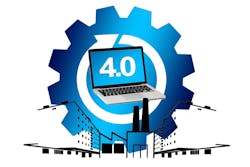Cabling Installation & Maintenance recently sat for an interview with Peter Jones, Chair, Ethernet Alliance and Distinguished Engineer, Cisco; and Bob Voss, Senior Principal Engineer, Panduit and an industrial automation industry technical expert and association member.
The interview was conducted the day after Cabling Installation & Maintenance’s recent 2-day online learning conference, the Emerging Applications in Data Center and Enterprise Networks Virtual Event, held August 11-12 in a series of 8 BICSI-accredited webinars.
Bob Voss is a member and advocate of leading industrial automation associations and a frequent industry presenter. Peter Jones and CIM had previously spoken on the topic of Single Pair Ethernet technology. Both Panduit’s Voss and Ethernet Alliance Chair Jones participated in producing the webinar series, with Voss presenting on Day 2 of the conference.
CIM: Obviously, Single-Pair Ethernet is what we’re talking about today, and with EA’s big SPE announcement that we covered (coincidentally and fortuitously occurring the week of our online conference) it seems like the push is really on for getting the latest SPE information out to the building and industrial automation industries. Peter, we’ve spoken before on the topic of SPE. Bob, could you describe your background and how it makes you distinctly qualified to comment on this topic?
Bob Voss: My qualifications are that I’m Senior Principal Engineer at the Caveney Innovation Center for Panduit and my expertise is building automation and industrial automation. I chair a couple of sub-committees; for one, the Ethernet Alliance SPE sub-committee. I’m also the chair of the Physical Layer Special Interest Group at ODVA; we defined the physical layer specification for industrial networks that are compliant with ODVA. In addition to that -- and really how Peter and I started collaborating very actively -- I‘m also involved with IEEE, TIA, IEC – organizations like that who deal in a wealth of OT network information. I’m really excited about SPE, because I’ve done it the old way, and I’m excited to do it this way.
CIM: I was surprised by 2 things that came out in the Q&A at the Cabling Installation & Maintenance ICT Roundtables Virtual Event. One was obviously from someone who had never heard of Single-Pair Ethernet before, wondering if it was simply some new thing from Panduit? That kind of took me aback. It feels like we’ve been covering SPE all the time, but I guess there’s a real need for more PR if some people are just hearing about it. It seems like there’s been a lot of news, but maybe it hasn’t been on everyone’s radar in the field? And then the other question: Somebody said it seems like IEC has been ahead of TIA on making the spec for the connector, and Bob revealed that IEC is in fact ahead -- but that’s as it should be?
Peter Jones: I’ll take the first question and Bob can take the second. If you remember what we did before with 2.5 and 5GBASE-T -- Cisco had been shipping it, and the standard was done, and people would still come up and say, “Wow, that’s a really cool idea – when will it happen?”
I think the reality is that all of our customers have day jobs, so even though we tell the story, they can’t hear it until they come up for air. So we’ve got to keep telling the same story. We can’t expect them to listen to us all the time. I think they key for us is to have the material available when they’re ready to hear it. If we as an industry look at something for a year and then get bored, we’ve done a disservice because people have other things to do with their lives.
BV: A lot of the benefit in the way the Ethernet Alliance is approaching SPE is, we’re to my mind the first group that’s really bringing a strong ‘what’s in it for me’ message. There are other people who have been in the marketplace talking about SPE earlier, but the message has been, hey there’s this thing called SPE – and we’re going to do something about it, here’s what we’re going to do. And it’s not really addressing, why do you care about it? what’s it going to do for you? – it’s just, there’s this thing, and we’ve got things to help you do it. So, to me it’s refreshing to have questions like the one about the IEC or some of the people who’re just like, wow, where’s this been, because it’s neat to see that it’s of interest and it validates what we’re trying to do [with] Ethernet Alliance.
CIM: You can’t hear about the, as I think Peter once described it to me, ‘word salad’ that comprises industrial automation protocols, without thinking about how SPE technology condenses that all down to just ‘Ethernet,’ for control. It seems to me that there must be a lot of factories out there who’ve been waiting to upgrade and might be interested in just going to straight Ethernet. What do you think – is it going to be a ‘rip and replace’ kind of thing, or because the technology is new, could it just be a retrofit?
PJ: I think the answer is, it’s complementary. We’re already seeing a whole bunch of the industry moving toward Ethernet, but there’s still this vast fieldbus gap on the edge. And this is something that’s been recognized in the industry for quite a while. We have slides that show this gap being described by ODVA in 2014. So it’s not ‘Single-Pair’ or something else; it’s Single-Pair to directly connect sensors and controls into the network, instead of going via fieldbus.
CIM: Can SPE work alongside previously deployed Ethernet technologies?
BV: What we’ve seen, especially as there’s become more unity between corporate IT and manufacturing – well, I go back to when I had dark hair and was starting in industrial automation: the way you got corporate IT to leave you alone was just to smile and say, OK you can help -- but there’s a life-safety issue here. And they’d go, oh ok, you got this, right Bob? Ok buddy, cool. But as IT gets more involved, they’re going to embrace it, they’re going to see the ability to have a seamless network that goes across the enterprise from the office all the way out to the shop, and they’re going to get a lot better stuff. And that pragmatism is already manifesting itself, because we see evolution not revolution.
They say, if we’re going to build a new diaper factory for Kimberly Clarke, we’re going to maintain what we’ve got that’s productive, we’ll upgrade it as necessary to keep it productive over its planned lifespan, but if we go all new, we’re going to go all new. So I think we’ll see rapid deployment of it as greenfield, and I think because of the fact that we went after the right topologies, to be able to duplicate the right topologies – you don’t have to build your factories or your buildings differently; it's just, here’s the topology you need, it’s now it’s just Ethernet running on that topology. I think we’ll be able to migrate, and that’ll be good. We’ll still be able to co-exist.
CIM: Could there be a situation where somebody has the WiFi running off NBASE-T, and then has IoT stuff happening with SPE?
PJ: I think there’s two things: there’s installed infrastructure and there are design patterns. If I wanted, for instance, to go and build myself a new factory and go all IP-style Ethernet, I’d have to rethink how I lay out that cabling from scratch. And if the guy signing the checks believes in that, that’s awesome; but otherwise, there’s a risk. I think being able to ay out the building the same makes a huge difference, if we can get re-use of physical topology, and I’m very optimistic we can. If I could lay out the infrastructure to support either, then I could basically put in the Ethernet in a small section and try it. I think the fact that we support the same types of media and topologies significantly reduces the risk of adopting new technology. If I’m going to build a plant that’s got to survive for 30 to 50 years, I care about that risk.
CIM: When you’re getting feedback from the industry, people that you’ve talked to that are learning about SPE or thinking about deploying it, what are the top 1 or 2 things that they’re talking about – is it that topology issue, or is it about the extended cable lengths? What is the thing that seems to be capturing most peoples’ imaginations?
BV: The thing I see a huge amount of excitement about, especially in the process industry, is the extreme distance. The fact that we can get out to a kilometer – people are really, really excited about that. And out to a kilometer delivering some conspicuous power. I mean, we’re going to start out at 90W on the PSE end, but we’re still going to have 8-10, 12 watts at the other end. And guys in the process industry think – when I say process industry, I mean oil and gas plants, petrochem plants, things that are large scale deployments -- a thousand meters is like heaven for them, they think that’s fantastic.
Plus, it’s Ethernet. You get the IP services that go along with Ethernet. You can do some of the cool parlor tricks that Ethernet can do, like plant-sensitive networking, that sort of thing. So the number one thing I see is the fact that we can get extreme distance with this, and deliver power. I guess the other thing that people are excited about is, kind of to steal Lindsey’s title from her slides, it’s ‘one protocol to rule them all.’ We’re not dealing with having to put in translation gateways at the edge of the network that say, well it’s speaking DeviceNet and I really need to get out Ethernet, so I’m going to have to put a translation gateway in here. It’s all speaking the same language, from the sensor to the cloud, and people are pretty enthused about that. I think that there’s a lot of excitement around those two factors.
About the Author
Matt Vincent
Senior Editor
Matt Vincent is a B2B technology journalist, editor and content producer with over 15 years of experience, specializing in the full range of media content production and management, as well as SEO and social media engagement best practices, for both Cabling Installation & Maintenance magazine and its website CablingInstall.com. He currently provides trade show, company, executive and field technology trend coverage for the ICT structured cabling, telecommunications networking, data center, IP physical security, and professional AV vertical market segments. Email: [email protected]



